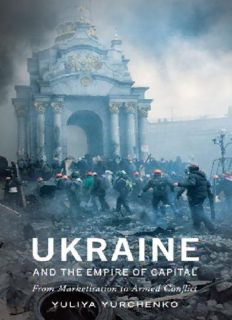
Ukraine and the Empire of Capital: From Marketisation to Armed Conflict PDF
Preview Ukraine and the Empire of Capital: From Marketisation to Armed Conflict
Ukraine and the Empire of Capital Ukraine and the Empire of Capital From Marketisation to Armed Conflict Yuliya Yurchenko First published 2018 by Pluto Press 345 Archway Road, London N6 5AA www.plutobooks.com Copyright © Yuliya Yurchenko 2018 The right of Yuliya Yurchenko to be identified as the author of this work has been asserted by her in accordance with the Copyright, Designs and Patents Act 1988. British Library Cataloguing in Publication Data A catalogue record for this book is available from the British Library ISBN 978 0 7453 3738 8 Hardback ISBN 978 0 7453 3737 1 Paperback ISBN 978 1 7868 0181 4 PDF eBook ISBN 978 1 7868 0183 8 Kindle eBook ISBN 978 1 7868 0182 1 EPUB eBook This book is printed on paper suitable for recycling and made from fully managed and sustained forest sources. Logging, pulping and manufacturing processes are expected to conform to the environmental standards of the country of origin. Typeset by Stanford DTP Services, Northampton, England Simultaneously printed in the United Kingdom and United States of America To the victims of capital Contents List of Figures and Tables List of Abbreviations Acknowledgements Preface Map of Ukraine 1. Per aspera ad nebulae or to market through a hybrid civil war: survival myths of systemic failure 2. Capitalist antecedents in the late USSR 3. Social destruction and kleptocratic construction of the early 1990s 4. Class formation and social fragmentation 5. Neoliberal kleptocracy, FDI and transnational capital 6. ‘Two Ukraines’, One ‘Family’, and geopolitical crossroads 7. The Bloody Winter and the ‘Gates of Europe’ 8. Geopolitics, the elusive ‘Other’, and the nebulous telos of Europe Notes Bibliography Index Figures and Tables FIGURES 4.1 The ‘coking coal–coke–metal’ and ‘thermal coal–power–metal’ commodity chains 4.2 Results of the parliamentary elections of 2002: parties with percentage of votes and parliamentary seats allocation 4.3 Network visualisation of SOEs privatised in 2003 and 2004 and companies/oligarchs who became their owners 5.1 Interlocking company membership in the global policy groups and the foreign business lobby and interest groups’ in Ukraine 5.2 Top 500 corporations in the policy groups in Ukraine (the latter dataset was last updated by the author in December 2010 5.3 ERT members’ companies representation in the EU and US lobby groups in Ukraine 5.4 Company membership interlocks among four foreign policy groups in Ukraine 6.1 Largest mass media outlet (television channels, newspapers and radio stations) ownership in Ukraine by oligarchs and FIGs 6.2 The most influential political, economic and public persons interlocks of 1990–1996, 2003, 2004 and 2005 6.3 Parliamentary elections 2006 results and seat allocation 6.4 Parties and factions in the Verkhovna Rada per number of allocated seats after elections of 2007 6.5 Interlocks of the most influential people of Ukraine 1990–1996, 2010 and 2011 6.6 The dynamic of interlocks among the most influential people of Ukraine ratings, 1990–2011 6.7 Top 100 companies in Ukraine’s market (2010) as per type and country of ownership 6.8 Ukrainian business groups’ corporate clusters share in Top 100 by numbers (2010) 7.1 State debt accumulation dynamic, billion dollars 7.2 Consolidated budget indicators, 2011–2016, UAH million 7.3 Gini, unemployment, and (hidden) income disproportionality, percentage; 1992–2015 8.1 Geographic structure of exports (goods), 1996–2016 8.2 Geographic structure of imports (goods), 1996–2016 TABLES 3.1 Murder cases associated with economic activity in Donetsk in the 1990s 4.1 Three main blocks of forces competing in the parliamentary elections 2002 4.2 The largest SEOs privatised in 2003–2004 5.1 Major investor subsidies in Special Economic Zones in Ukraine; established 1998–2000 6.1 Political parties’ preferences in 2003–2004 6.2 Gas distribution SOEs privatised in August–October 2012 8.1 Geographic structure of exports (goods), 1996–2016 8.2 Geographic structure of imports (goods), 1996–2016 Abbreviations ACC American Chamber of Commerce CIS Commonwealth of Independent States CPSU Communist Party of the Soviet Union CSTO Collective Security Treaty Organization CUSUR Centre for US–Ukraine Relations DCFTA Deep and Comprehensive Free Trade Areas EBA European Business Association EBRD European Bank for Reconstruction and Development ERT European Round Table of Industrialists ETG Eural Trans Gas FDI Foreign direct investment FIGs Financial industrial groups ICC International Chamber of Commerce IFIs international financial institutions IMF International Monetary Fund ISD Industrial Union of Donbass (Індустріальний союз Донбасу) JSCs Joint Stock Companies KIIS Kyiv International Institute of Sociology Maidan Maidan Nezalezhnosti (Independence Square), the main square of Kiev maidan social movements associated with the Orange Revolution and the Bloody winter NDP (Narodno-Democratychna Party) People’s Democratic Party NRU (Narodnyy Rukh Ukrayiny) People’s Movement of Ukraine PDAs Priority Development Areas PIIGS Portugal, Italy, Ireland, Greece and Spain SALs Structural adjustment loans SAPs Structural adjustment programmes SAPs Structural adjustment programmes SCM System Capital Management SDPU(U) Social-Democratic Party (United) SEZs Special Economic Zones SOEs State-owned enterprises SSR Soviet Socialist Republic UAH Ukrainian Hryvnia – the currency of Ukraine URPP Ukrainian Union of Industrialist and Entrepreneurs USUBC US–Ukraine Business Council WB World Bank WIDER The World Institute for Development Economic Research WTO World Trade Organization YeESU United Energy Systems of Ukraine (Yedyni Energetychni Systemy Ukrayiny) YES Yalta European Strategy
Description: